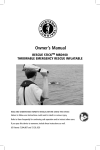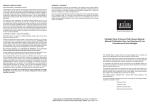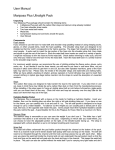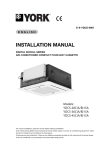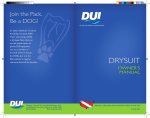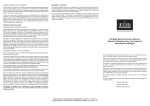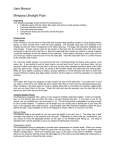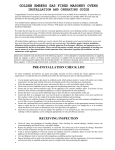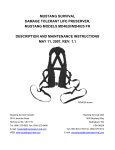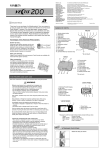Download MSD901 - Mustang Survival
Transcript
MSD901 Industrial Dry Suit User's Manual i i ii ii ii ii CONTENTS Things You Should Know Application Configuration Maintenance and Care Inspection Warranty Contact Assembly 1– 6 The MSD901 Assembly Steps 7 8 8 9 Donning Suit Preparation Prior to Donning Donning Instructions Closing Waterproof Zipper Adjusting the MSD901 After Donning 9 9 9 9 Securing The MSD901 General Neck Seal Wrist Seal Hood Doffing 10 Removing the MSD901 11 11 12 13 Maintenance And Care General Outer Shell Immersion Module Thermal Liner Inspection General Suit Examination Inspection Intervals Outer Shell Immersion Module Thermal Liner Additional Information 15 Suspenders 16 Trim to Fit Wrist Seals 13 13 14 14 14 Mustang Survival®, Inc. MSD901 Industrial Dry Suit Things you should know Application The MSD901 industrial dry suit may be used in lieu of traditional dry suit and anti-exposure work suits when a suit of greater durability, comfort and protection from exposure to cold is required. The MSD901 provides inherent buoyancy as well as protection from exposure to cold temperature, wind, sea spray and rain. WARNING For optimum performance, it is recommended that users wear polypropylene underwear beneath the MSD901. Configuration The MSD901 provides hypothermia protection and inherent buoyancy using three interconnected modules to form a single system. Each module can be repaired or replaced individually. The first module incorporates Mustang’s patented breathable foam (United States Patent No.5267519 and Canadian Patent No.2082793); it is a thermal liner that functions as a second layer of protection and provides inherent buoyancy. The second module is the immersion module and provides the suit with watertight integrity and the equivalent protection of a dry suit. Constructed of a waterproof and breathable (moisture vapor permeable) fabric GORE-TEX® BD6.5®, this module’s sleeve openings maintain watertight integrity with neoprene seals. The immersion module’s (United States Patent No.6,668,386 and Canadian Patent No.2,381,720) neck seal is constructed of a waterproof, breathable polyurethane/polycarbonate-coated nylon stretch material and is closed via an adjustable, elastic drawstring system that effectively seals water outside the module and provides comfortable wear. Sock-type feet are integrated into the legs. The third module is the outer shell urethane-coated nylon shell which provides a durable water-resistant barrier to wind, sea spray and rain. This module is vented allowing the suit to breathe. The knee and seat portions of the outer shell are reinforced. An integral foam-lined hood provides protection both in and out of the water. i Thermal Liner FIGURE 1 MSD901 Industrial Dry Suit Immersion Module Outer Shell FIGURE 2 MSD901 Industrial Dry Suit Layers Maintenance And Care Maintenance is limited to cleaning the MSD901 and lubricating its waterproof zipper. Ensure that your Mustang product is completely dried before storing it in a dry, well-ventilated location. (Refer to Maintenance and Care instructions on page 11 for more information). Inspection Periodically examine your MSD901 for signs of abrasion or damage. Should a Mustang product require manufacturer’s inspection, please contact your Mustang Survival dealer (refer to page 13 for inspection protocol). Warranty Mustang products are warranted to be free from defects in material and craftsmanship for a period of one year after date of purchase by the end user. Products which, in Mustang Survival’s sole judgement, have received excessive or abusive use will not be covered by this warranty. Contact If you require more information on your Mustang product, please contact us at: USA Canada Mustang Survival, Inc. 3870 Mustang Way Bellingham, WA 98226 TOLL FREE (800) 526.0532 3810 Jacombs Road Richmond, B.C. Canada V6V 1Y6 TOLL FREE (800) 526.0532 ii WARNING THE MSD901 SHOULD BE WORN WITH ALL THREE MODULES ASSEMBLED. THE MODULES ARE NOT DESIGNED TO BE WORN INDEPENDENTLY, AND A LOSS OF PROTECTION AND WEAR RESISTANCE WILL RESULT IF WORN IMPROPERLY. Assembly MSD901 Assembly Steps STEP 1 Lay out the thermal liner and immersion module a) Lay out the thermal liner and the immersion module side by side in the same orientation as if you were going to wear them. Note: Check the labels of the thermal liner to ensure that they are located on the inside (the seams of the thermal liner should face out). b) Make certain the neck seal adjustment on the immersion module is fully open and facing up. Make sure the waterproof zipper is fully opened. Thermal Liner Immersion Module FIGURE 3 MSD901 Industrial Immersion Work Suit Layers 1 STEP 2 Connect the thermal liner and the immersion module at the ankle a) Fold the top half of the immersion module over at the waist toward the legs. Ensure the lower portion of the module is exposed. b) Keeping the bottom flat and straight, use an overhand grasp to insert each leg of the thermal liner down into each leg of the immersion module until it reaches the interconnection zipper at the ankle (see fig. 3). Note: Ensure the legs do not twist, maintaining a matching orientation during insertion. c) After pushing your hand down between the thermal liner and the immersion module, grab the thermal liner ankle zipper and the immersion module zipper. d) Pull both legs out together, turning them inside out to expose the zippers (see fig. 4). e) Attach the two ankle zippers. The immersion module zipper will only work in one direction (see fig. 5). Apply the same procedure to the other leg. f) Push the two legs completely down into the immersion module ensuring they are aligned. Immersion Module Ankle Zipper Thermal Liner Thermal Liner Ankle Zipper Thermal Liner Ankle Zipper Immersion Module Immersion Module Thermal Liner Immersion Module Ankle Zipper FIGURE 4 Pulling a Leg Out Exposing the Zipper FIGURE 5 Thermal Liner and the Immersion Module Connected at the Ankles STEP 3 Suspenders (MA7650) See Suspenders section (p. 15) for detailed instructions for suspender attachment. 2 STEP 4 Waist and waterproof zipper connection - Part I a) Return the immersion module to its laid out position in Step 1. Push the left arm of the thermal liner down to the end of the left arm of the immersion module (see fig. 6). b) Repeat this procedure with the right arm. c) To join these layers together, start at the end of the waterproof zipper underneath the left arm and close the length of the lower interconnection zipper (see fig. 7). d) Fold the two layers out and lay them flat. STEP 5 Wrist connection a) Push your hand between the two layers down the left arm, grab the arms at the interconnection zippers and pull both arms through. b) Line up the zipper on the immersion module with the zipper on the cuff of the thermal liner and connect them (see fig. 8). c) Push the cuffs back through the arm to the normal position. d) Repeat this procedure for the right arm. Note: Ensure the arms do not twist, maintaining a matching orientation during insertion. Immersion Module Thermal Liner Waterproof Zipper Immersion Module Upper Interconnection Zipper Immersion Module Immersion Module Lower Interconnection Zipper Thermal Liner Lower Interconnection Zipper FIGURE 6 Insertion of the Thermal Liner Into the Arm of the Immersion Module 3 Thermal Liner Upper Interconnection Zipper FIGURE 7 Closing the Lower Interconnection Zipper STEP 6 Neck connection a) Grab the edge of the neck seal on the immersion module and expose the interconnection zipper. b) Line up the end of the zipper on the immersion module with the end of the zipper on the thermal liner (see fig. 9). c) Fasten the zipper and continue to close until the two are completely joined, then fold the neck seal back down. CAUTION Avoid pinching the waterproof material of the immersion module with the zipper slider. STEP 7 Waist and waterproof zipper connection - Part II a) Complete the connection of the immersion module to the thermal liner by starting at the end of the interconnection zippers that are located at the end of the opened waterproof zipper. Close the length of the upper interconnection zipper (see fig. 7). b) Lay the modules out flat. Thermal Liner Wrist Zipper Immersion Module Wrist Zipper Thermal Liner Neck Zipper Immersion Module Neck Zipper Immersion Module Neck Seal Folded Back Thermal Liner Immersion Module FIGURE 8 Thermal Liner and the Immersion Module Connected at the Wrist FIGURE 9 Connecting the Thermal Liner and the Immersion Module at the Neck 4 STEP 8 Adding the outer shell a) Lay the outer shell out flat with the chest zipper facing up. Lower the chest and ankle gusset zippers. Completely loosen the wrist adjustment straps. b) Fold the outer shell over at the waist exposing leg openings. c) Feed the left leg of the thermal liner/immersion module assembly through the left leg of the outer shell and pull it through. Repeat this procedure for the right leg (see fig. 10). d) Feed the left arm of the assembly through the left arm of the outer shell and pull it through. Repeat this procedure for the right arm. Do not connect the wrist interconnection zippers yet. e) Pull the neck seal up to the neck of the outer shell. STEP 9 Outer shell waist and waterproof zipper connection a) Fold back the protective flaps of the outer shell to give access to the interconnection zippers. b) Line up the two ends of the lower interconnection zipper on the immersion module with the corresponding zipper of the outer shell. Connect the two ends and fasten them the length of the zipper (see fig. 11). Immersion Module Foot Protective Cover Outer Shell Interconnection Zipper Outer Shell Leg FIGURE 10 Leg of the Thermal Liner/Immersion Assembly Fed Through the Outer Shell 5 Immersion Module Interconnection Zipper FIGURE 11 Closing the Upper Interconnection Zipper between Immersion Module and the Outer Shell c) Line up the two ends of the top interconnection zipper on the immersion module with the corresponding zipper of the outer shell. Connect the two ends and fasten them the length of the zipper. d) Lay the suit out flat. STEP 10 Outer shell wrist connection a) Fold back the left wrist of the outer shell exposing the interconnection zipper. b) Line up the zipper with the neoprene wrist zipper and connect the two securely (see fig. 12). c) Fold the wrist of the outer shell back over to cover the interconnection zipper. d) Repeat this procedure for the right wrist. WARNING THE MSD901 SHOULD BE WORN WITH ALL THREE MODULES ASSEMBLED. THE MODULES ARE NOT DESIGNED TO BE WORN INDEPENDENTLY, AND A LOSS OF PROTECTION AND WEAR RESISTANCE WILL RESULT IF WORN IMPROPERLY. Immersion Module Wrist Zipper Outer Shell Wrist Zipper Outer Shell Cuff Folded Back FIGURE 12 Connecting the Immersion Module and the Outer Shell at the Wrist 6 Donning STEP 1 Suit preparation prior to donning a) Loosen the neck seal completely. b) Ensure that the wrist, thigh and ankle adjustment straps are fully loosened. c) Make sure that the chest zipper is fully opened. d) Unzip and fold back the chest ventilation zippers to expose the waterproof zipper. (refer to page 13 for regular zipper maintenance) e) Fully open the waterproof zipper. CAUTION USE EXTREME CAUTION WHEN DONNING THE MSD901. PRIOR TO DONNING THE MSD901, REMOVE ALL RINGS, WATCHES, EARRINGS, NECKLACES AND EYEGLASSES THAT WILL CAUSE DAMAGE TO WRIST AND NECK SEALS. STEP 2 Donning instructions a) Pick up the MSD901 and fold the top forward, over the waist. b) Slowly slide your legs in until your toes reach the end of the socks (see figure 13). c) Gently push one hand through the wrist seal using the index finger of the opposite hand to stretch the seal as you push your hand through. Repeat for the opposite hand. Flatten any folds or rolls of the seal against the skin (see figure 14). d) Bring the upper portion of the suit over your head, aligning the neck opening with the top of the head. Reach inside the top of the neck seal with the fingers and gently pull the seal outward and down as you push your head through. Flatten any folds or rolls of the seal against the skin. 7 FIGURE 13 Inserting Legs Into the MSD901 Industrial Immersion Work Suit FIGURE 14 Donning the MSD901 Industrial Immersion Work Suit FIGURE 15 Pulling the Zipper to Close the Suit 8 STEP 3 Closing the waterproof zipper a) Fold the protective cover away to expose the waterproof zipper. b) Grasping the open end of the waterproof zipper with your left hand, begin pulling the zipper slider with your right hand, continuing to close the waterproof zipper as far as you can (see fig. 15). c) Switch hands and with your left hand grasp the zipper slider and continue closing the waterproof zipper until it is completely closed while holding the suit with your right hand to gain leverage. WARNING Failure to completely close the waterproof entry zipper and the relief zipper will result in leakage of water inside the suit and reduction in survival time when in the water. Have a fellow crew member double check each slide fastener to ensure they are completely closed against their sealing plugs. d) Unfold the protective cover over the waterproof zipper and snap it in place at the ends. Adjust the chest ventilation zippers on the outer shell. STEP 4 Adjusting the MSD901 after donning a) Adjust the neck seal to a snug but comfortable fit. Do not tighten the neck seal to the point where it is uncomfortable (see fig. 16). b) Secure the ends of the neck seal drawstring to the tab located at the outer edge of the neck seal. c) Close and adjust the outer shell waist belt. d) Adjust the ankle, thigh and wrist straps. FIGURE 16 Adjusting the Neck Seal 9 Securing The MSD901 In Emergency Situations 1. General - In the event of immersion, the MSD901 has a number of emergency features that are crucial to your survival. 2. Neck Seal - After entering the water, tighten the patented neck seal by grasping the drawstring and pulling the tabs out and away from the neck until a snug, comfortable fit is achieved. 3. Wrist Seals - The neoprene wrist seals will prevent the entry of water into the suit. Tightening the wrist closures will improve the watertight integrity of the wrist seals. 4. Hood - The hood, if not deployed already, can be removed from its stowed position. Tighten the drawstring on both sides of the hood to secure it about the face. Doffing Procedure The following procedure is for removing MSD901: a) Remove all other equipment donned over the MSD901 before proceeding. b) Wash down the MSD901 while wearing it paying particular attention to entry and relief slide fasteners. Remove all traces of salt. c) Unbuckle the waist belt and release the ankle, wrist and thigh adjustment straps. CAUTION FAILURE TO COMPLETELY OPEN THE WATERPROOF ZIPPER WILL DAMAGE THE SUIT WHEN IT IS REMOVED. d) Fold the waterproof zipper cover out of the way. Completely open the waterproof zipper. e) Completely loosen the neck seal drawstring and open the chest zipper. f) Insert fingers between neck seal and neck. Gently stretch the seal outward and upward while pulling head out of the suit. g) Insert two fingers under wrist seal and gently pull seal outward. Cup the hand, fingertips and thumb together, and gently pull hand from seal. Repeat for other hand. h) Remove legs from suit. Hang the suit by the hanging loop, close waterproof zipper half way and allow to hang until dry. 10 Maintenance And Care 1. General After use and immersion in water (other than fresh clean water), the suit modules should be either washed or rinsed separately. To increase the life of the garment, it is recommended to wash the suit only when required. For spot cleaning of the exterior when assembled, hand wash the suit in fresh water (100˚F or less) using a mild powdered soap solution, then hang to air dry. WARNING Do not hang the suit by the neck seal. Use a wooden hanger and support the suit by the outer shell, using the hanging loop located inside the outer shell neck area to secure the suit while drying. Do not use bleach or other chlorine products. Do not use liquid soaps or fabric softeners. Do not dry clean. Ensure all pockets are emptied and layers have been separated. Note: Unzip all interconnection zippers before laundering. Separating the layers a) Remove the suspenders (p.15) and thermal hood. b) Roll back the outer shell wrist material approximately 3 inches to expose the wrist interconnection zipper. c) Unzip interconnection wrist zippers. d) Repeat steps (a) and (b) for the opposite wrist. e) Fold open the outer shell around the waist to expose the upper and lower waist interconnection zippers. f) Unzip the upper zipper in the center of the back. g) Unzip the lower zipper to completely disconnect the outer shell from the immersion module. h) Remove the outer shell from the immersion module. i) Completely loosen the neck seal drawstring. j) Roll back the neck seal exposing the neck thermal lining interconnection zipper. k) Unzip the neck thermal lining interconnection zipper. 11 l) Unzip the waterproof zipper around the waist circumference and fold the suit open to expose the upper and lower waist interconnection zippers. m) Unzip the upper and lower waist interconnection zippers. n) Unzip the upper and lower interconnection zippers adjacent to the waterproof relief zipper. o) Reach between the immersion module and thermal liner to the wrist and pull the wrist cuff through (inside out) exposing the interconnection zipper. p) Unzip the wrist interconnection zipper. q) Repeat steps n) and o) for opposite wrist. r) Reach between the immersion module and thermal liner to the ankle and pull the ankle cuff through inside out exposing the ankle interconnection zipper. s) Unzip the ankle interconnection zipper. t) Repeat steps q) and r) for opposite ankle. 2. Outer shell a) Empty contents from all pockets, including the thermal hood. Inflatable Pillow b) Close all vent and pocket zippers prior to washing outer shell c) Unsnap and fold open the hood. FIGURE 17 d) Remove the inflatable pillow from the suit (see fig. 17). e) Machine wash in warm water (100˚F) using mild powdered soap. f) Hang the outer shell to air dry. g) Outer shell may be tumble-dried on a low heat setting. h) Upon drying, replace the inflatable pillow in the suit. 3. Immersion module a) Machine wash in warm water (100˚F) using mild powdered soap. b) Hang the immersion module to air dry. 12 c) Immersion module may be tumble-dried on a low heat setting. d) Zipper cleaning is the first step to zipper longevity. Clean the zipper of any mud, sand, salt or foreign elements. First, use warm soapy water to remove any heavy deposits and then use one of the recommended cleaning fluids listed in the chart below. Finally, apply a recommended wax for easy zipper movement. A daily use suit requires the application of wax to the waterproof zipper once per week. CLEANING FLUID LUBRICATING WAX Product Name Supplier Product Name Supplier Zippy Cool Zip Care BDM Fluid YKK USA McNett BDM UK Zippy Cool Zip Wax BDM Wax YKK USA McNett BDM UK 4. Thermal liner a) Wash by hand in warm water using a mild powdered soap. b) Rinse thoroughly in clean water. c) Hang to air dry. Note: Ensure that the outer shell, immersion module and thermal liner are completely dry before reassembling. Inspection General Suit Examination Periodically examine your MSD901 for visual signs of abrasion or damage. Lay the suit out on a clean, flat surface. Make sure that the suit is dry inside and out. Visually check for small rips, tears, or punctures that can be repaired by a suitable repair station*. Major rips, tears, or punctures should be referred to Mustang Survival for inspection and repair. *Contact Mustang Survival Corp. for more information. Inspection Intervals The suit should be inspected: a) On receipt from the supply depot or contractor. b) Periodic inspections; depending on the environmental conditions of usage, not to exceed 90 days unless in storage. c) Before and after use by the individual issued the suit. 13 d) Whenever the integrity of the suit is in doubt. Outer Shell Inspect the outer shell over its entire surface area for cuts, tears and seam separations. Any damage found should be repaired prior to further use. Head Pillow Check inflatable head support for damage and ensure that it is properly attached. Check inflation hose(s) for deterioration or leaks. The head support/ buoyancy ring should be inflated and tested for leaks at least every three months: a) Inflate the bladder, then immerse it in water and check for bubbles. (Ensure that the suit is completely dry inside and out before returning it to its bag.) b) Inflate the bladder, let it stand for 8 hours and then check it for firmness. Minor leaks can be repaired by a suitable repair station using aquaseal adhesive. Major leaks should be evaluated and repaired by Mustang Survival. Retro-reflective Tape Check retro-reflective tape for condition and adhesion. Replace if necessary. For best adhesion, repair should be completed by a suitable repair station or sent back to Mustang Survival. Immersion Module Inspect the immersion module over its entire surface area for cuts, tears and seam tape separations. Return the immersion module to Mustang Survival for repairs or replacement. Zipper Check for ease of zipper operation by sliding it up and down. Using lubricant recommended by Mustang Survival (see page 13), lubricate the front and back of the zipper and the slide fastener. If the zipper is not functional, the suit must be removed from service and discarded or returned to Mustang Survival for repair. Thermal Liner Inspect the thermal liner over its entire surface area for cuts, tears and seam separations. Any damage should be repaired prior to further use. 14 SUSPENDERS (MA7650) Suspenders are not required when using the MSD901, unless sizing dictates. However, properly attached suspenders may improve the fit and mobility. The MSD901 is equipped with attachment loops, on the Immersion Module, that accommodate the suspender system. Remove and re-attach as required. Suspender Attachment Instructions Required materials: MSD901 and two suspenders. a) Completely unzip the MSD901 entry zipper (Fig. 18) FIGURE 18 FIGURE 19 b) Open the suit so that the (front and back) attachment loops are accessible (Fig. 19). c) Attach the end of the suspender, with the buckle, to the suit’s front attachment point by unpeeling the Velcro flaps and lifting the Velcro strap that is folded on itself. Fold the flaps over the strap (so that hook Velcro faces hook Velcro). Pass the suspender through the attachment loop. The strap end can now be folded over itself so the Velcro patches close. To secure the suspender, wrap the Velcro flaps around the edges of the strap and attach to Velcro on the opposite side of the strap (Fig. 20). FIGURE 20 15 d) Pass the suspender strap through the front and back pass-through slots on the Thermal Liner. While keeping the strap straight, attach the non-adjusting end of a suspender to the suit’s back attachment point (Fig. 21). Should be similar to Step c. FIGURE 21 e) Repeat these steps to attach the other suspender. It is recommended to use two suspenders for even support. f) The suspenders may be attached so they are crossed over the user’s back. g) Use the suspender strap ends to adjust for a secure comfortable fit. FIGURE 22 TRIM TO FIT WRIST SEAL INSTRUCTIONS Your suit comes equipped with universal-sized wrist seals that have a tapered sealing surface at the end of the cuff. This tapered end allows you to modify the size of the cuff opening to match the physical characteristics of your hand and wrist. Trimming the end of the cuff increases the diameter of the end opening, allowing a larger wrist to be inserted and sealed comfortably without damaging the cuff. Users with unusually boney 16 wrists should try to make the wrist seal fit properly further up the arm where the sealing surface is smooth. NOTE: Once the wrist seal is trimmed, it may not provide an adequate seal for a smaller wrist. Required materials: Ruler, sharp scissors and talcum powder. See below for trim to fit wrist seal instructions for used suits. Trim to Fit Instructions - New Suits The trim table below details recommended “Trim Off” lengths relative to wrist size. To ensure a watertight seal that provides safety, the fit should be slightly uncomfortable without cutting off circulation to your hand. Don’t cut off more wrist seal than recommended, otherwise the safety provided may be compromised. a) Use a tailor’s measuring tape or some other means (string) to determine each wrist circumference (measure just above the wrist joint towards the elbow). Left and right wrist sizes may vary. Measure again to confirm (Fig. 23). FIGURE 23 FIGURE 24 FIGURE 25 FIGURE 26. Trim Guide Trim Off To Fit Wrist 0” 5 1/2” - 6” 1/4” 6 1/2” 1/2” 7” 3/4” 7 1/2” 1” 8” 17 b) Refer to the trim table above and determine the recommended “Trim Off” amount. (Eg: a wrist size of 7” requires approximately 1/2” be trimmed from the cuff end). c) If wrist circumference is 6” or less, try on the cuff “as is” to gauge the comfort and seal provided. Continue with trimming only if required. d) If trimming is required, mark a circular line around the cuff that is offset from the original cuff end by the recommended “Trim Off” amount (Fig. 24). e) Using sharp scissors, or a razor, carefully cut the cuff end at the marked line. Evaluate the fit and comfort after each cut. Apply talcum powder to your hand and wrist to make donning the cuff much easier. Don the sleeve by pointing the fingers straight, tucking the thumb underneath and inserting the hand through the seal. Do not make a fist when putting your wrist through the seal. Forcing the wrist through a cuff that is too small may tear the cuff end open (Fig. 25). f) If further trimming is required, shorten the cuff end 1/8” at a time until the optimum balance of fit and comfort is achieved. It is not recommended to exceed the original cut by more than 1/2”. g) To maximize the protection provided by the wrist seals, try to minimize flexing of the hand-wrist-arm muscles when in the water. Trim to Fit Instructions - Used Suits The condition of a used suit may not be obvious, so carefully don each of the wrist seals prior to trimming. To ensure a watertight seal that provides safety, the fit should be slightly uncomfortable without cutting off circulation to your hand. Don’t cut off more than the required amount, otherwise the safety provided by the wrist seal may be compromised. Perform the following steps to trim the wrist seals of a used MSD901. a) Apply talcum powder to your hand and wrist to make donning the cuff much easier. b) Don the sleeve by pointing the fingers straight, tucking the thumb underneath and inserting the hand through the seal. Do not make a fist when putting your wrist through the seal. Forcing the wrist through a cuff that is too small may tear the cuff end open. c) If further trimming is required, shorten the cuff end 1/8” at a time until the optimum balance of fit and comfort is achieved. To maximize the protection provided by the wrist seals, try to minimize flexing of the hand-wrist-arm muscles when in the water. 18 WE SAVE LIVES FOR A LIVING MUSTANG SURVIVAL CANADA 3810 Jacombs Road, Richmond, B.C., Canada V6V 1Y6 TOLL FREE TEL FAX E-MAIL WEB 1.800.661.6181 604.270.8631 604.270.0489 mustang@mustangsurvival.com www.mustangsurvival.com MUSTANG SURVIVAL USA 3870 Mustang Way, Bellingham, WA USA 98226 WEB 1.800.526.0532 360.676.1782 360.676.5014 mustangusa@mustangsurvival.com www.mustangsurvival.com HT Rev -- Printed in Canada (23 Oct 06) TOLL FREE TEL FAX E-MAIL






























